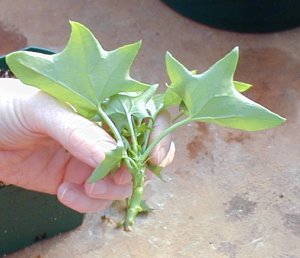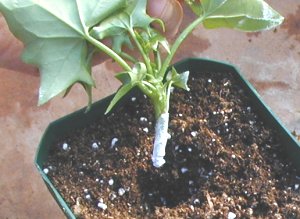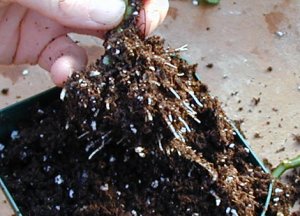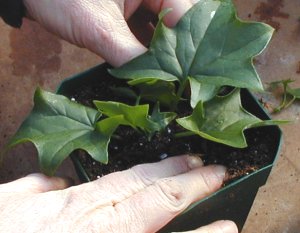We have been using the same German ivy for many years. We have not had to buy a plant in more than 5 years. It’s fast growing and will fill a basket and trail down more than 2 feet given enough time. I’m told this is not really an ivy but a vine. That makes sense as the stems are more succulent than woody.
It keeps well in the house or greenhouse and it puts out pungent yellow flower masses, if we let it. Actually the fragrance is not what you would call pleasant. As a matter of fact it stinks worse than dirty socks.
The first time we had a bloom in the greenhouse we thought something had got in a died.
Today we took 3 baskets we kept from last year and trimmed all the terminal ends off. Then we dipped the ends in just a bit of rooting hormone and stuck them into 4 inch pots filled with pro-mix. We will keep the pots damp and in the shade for a few weeks and until the plants have taken root and started to grow.
This stuff is really easy to root and a look at one of the trailing stems will tell why. At every joint the plant sends out new shoots and in many cases they send out roots as well. The rooting hormone is probably over kill but we only use a very small amount and it is cheap insurance.
The plants also root if the stems are allowed to contact soil for a week or 2 and a cutting put in water will grow roots in very little time.
Once the German ivy is well rooted and sending off new shoots we will transplant some of them into 10 or 12 inch baskets. We normally use 3 plants per basket if they are to be planted alone. This ivy works very well with ivy geraniums but we need to be careful to make sure the geraniums are larger and well established. Otherwise the German ivy will take over and bury the geraniums.
The German ivy works well with moderate light and will thrive in lower light conditions. We let the plants dry out a bit between watering.
The biggest pest problems seem to be aphids and mealy bugs but this problem is not so pronounced when the plants are growing out doors.
Last year we put 4 really nice flats out to get some fresh air and they were hit by an un-forecast frost. The plants came back but they were not so well formed as before. This is just one of the challenges when growing in our cold weather zone 4 climate.
UPDATE:
It has been 10 days and the ivy has 1/4 inch roots. Even the trimmed leaves are starting to root and all the plants have new growth. Now the challenge is to keep the beasties away. We only use organic pest control and the greenhouse is growing all year long so we can not let up. Pyola oil about every 7 to 10 days does the trick.
STEP BY STEP instructions on propagating German Ivy with photos.

Step One. Choose a 2 to 3 inch section from a healthy plant and snip it off with clean shears or using a knife or razor blade.
choose a section from a healthy plant

Step 2. Pull the leaves off the bottom 1 to 2 inches.
Pull the bottom leaves off

Step three. Dip the lower 1/2 inch or so into rooting hormone.
Dip the lower portion into root hormone

Step four.Fill a pot with Pro Mix and poke a 2 inch hole in the center.
poke a hole in the soil

Step five. Check the roots. These roots are about 10 days old.
German ivy roots at 10 days

Step six. Put the stem in the hole and firmly tamp the soil.
tamp the soil down

Water the pot and place in a warm, 70 degree F., and shady area until the plant send out roots. A low nitrogen liquid fertilizer will help roots to grow. We use Age Old Organics 5-10-5 for starting cuttings. Keep the soil moist, not drenched. German ivy can take some sun but likes shade too.
place in shade until roots grow

Leave a Reply
You must be logged in to post a comment.